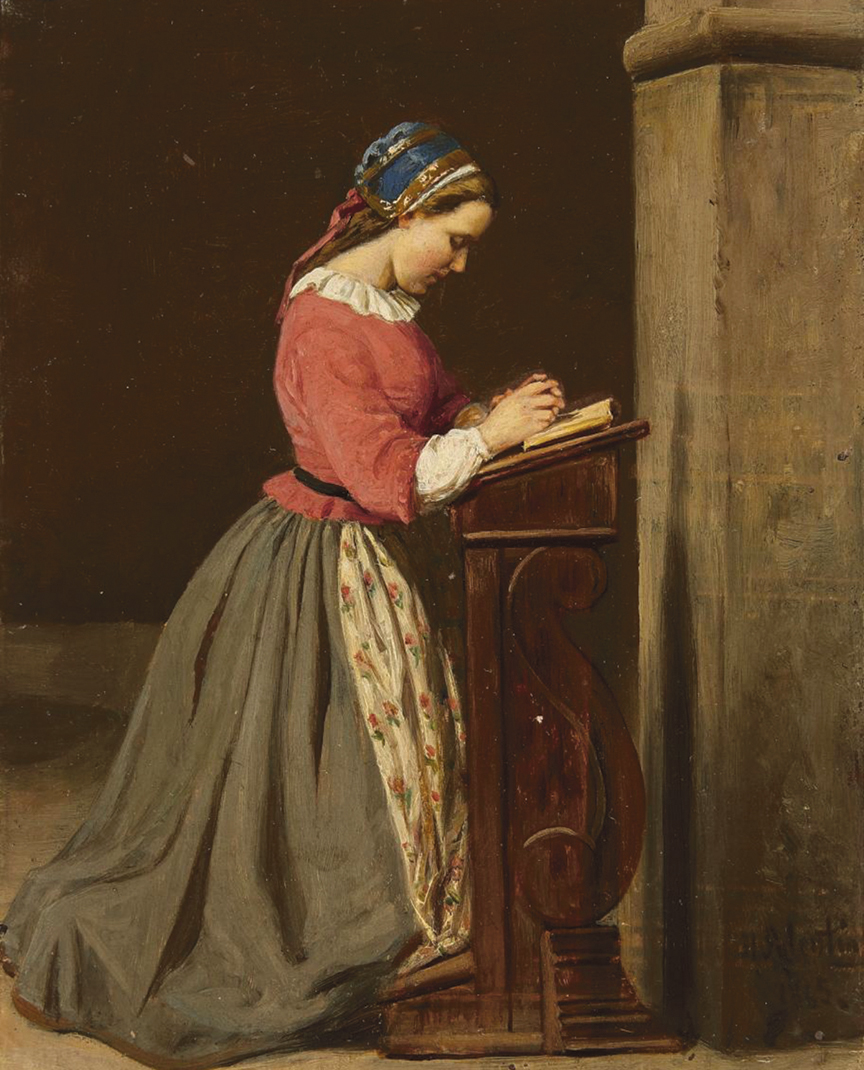Faithful Unto Death – Katherine’s Christmas Eve Vow

PHOTO: On that Christmas Eve as Katherine knelt at that chapel altar she pleaded to be shown the path she should take in life. Painting by Hubert Salentin – Young Girl Praying.


by Robert Hanaford Smith, Sr.
Weirs Times Contributing Writer
Sometime in the 1880’s William Clough wrote that he temporarily left a joyous and happy annual family gathering to visit the burial grounds of his deceased kindred in his native New England town. On leaving the cemetery he saw the inscription on a white marble marker that brought back the memory of an unusual lady whose story he decided to pass on to others. The woman in the story was unique and the story itself is not what you might call your traditional type of Christmas story, and like many of our life experiences it is bittersweet. Even with my condensed version, in order to do justice to the story, first published in 1889, I must give it to you in two parts.
The marble gravestone in the town cemetery read, Katherine Pollock, 1838-1878, Faithful Unto Death. With some direct quotes from Clough the legend follows: It was on a Christmas Eve that a young Katherine Pollock knelt at the altar of a chapel in a country town somewhere in the hills of New England and made the vow that determined the course of her life. “Her childhood and youth were full to overflowing with the light-hearted and merry joys that are the experience of the youngest and petted member of the family. Nothing in reason was denied…”
This child, who was the youngest and a recipient of the most attention by the rest of the family, did not become the selfish and demanding person we might have expected. On the contrary, her home influence and education were such “that she developed into the best type of serious and admirable womanhood.” However that Christmas Eve vow meant that she would be a Miss, and not a Madam, all the days of her life.
On that Christmas Eve as Katherine knelt at that chapel altar she pleaded to be shown the path she should take in life. Before she left that sacred place, satisfied that she had received her answer, Katherine surrendered all of her desires for happiness as a wife and mother with the happiness provided by a family of her own and “dedicated herself to the service of others.”
Her first call to duty was not long in coming because Katherine, as the youngest of the family, found herself at home alone with her parents as the last of her siblings had left the nest. By this time her parents were old and needed someone to provide sight for failing eyes and strength for hands which were weakening. The “path of duty” required young Katherine to forego the usual associations with other young people in order to care for father and mother day and night and to be the joy and sunshine of the home in “the Indian summer of their lives.”
After her father and mother had died Katherine stayed alone in the old house for a few months and then left to go to the city to find employment. For three years she worked as a saleslady, conducting herself in such a way that her associates saw in her the ideal in womanhood. These years seemed to consist of a maturing time for the young lady, preparing her for some difficult days ahead when she would fulfill her vow to help others.
The advent of the Civil War brought another call to duty. After some weeks of thought on her next move Katherine once again thought direction on a Christmas Eve on her knees in a church. The message that came to her was that her country was calling her to serve and she must obey. So she obeyed the call to be faithful to death and go to bind up the battle wounds of the soldiers in the war camps and hospitals. The message was to bring consolation to those who were casualties of the war, and to be a mother, sister, counselor and friend to them. In return she was promised that she would experience an abiding peace that the world could not give her.
So she went and ministered to the wounded for four years, not caring whether their uniforms were blue or gray. She was there trying to relieve their suffering, writing letters for them, and consoling them when they were dying.

When the war was over Katherine Pollock returned to her home town and the old house where she had spent her childhood and young adult years. At first, alone in the old homestead, she felt like things in the old town were just like they were when she had left it years before. It didn’t take long for her to realize that things were radically different.
Everything and everybody in the neighborhood had undergone change. Children had grown up. Many of the young men were missing; some of them had died in the war. Girls had grown up, married, and moved away. Few of the townspeople knew anything about Katherine’s life since she had left town and all were curious as to why she had returned. Some looked upon her with suspicions and few offered their friendship.
A fresh call to duty prompted Katherine to go from home to home in the New England town of her birth ministering to the sick and needy. Mr. Clough wrote: “She was a ministering angel to the poor and needy, a friend to every worthy cause, a wise and safe counselor to the young, and a sympathizing visitor to those who were burdened with domestic cares and worried about the future.”
She gained the people’s confidence and they came to realize her worth. As time passed they came to the conclusion that as far as noble women were concerned that Katherine Pollock was “one in a thousand.” The vow to spend her life dedicated to helping others while giving up her own ambitions was now benefiting the people she had known in her youth.
Then something suddenly happened that shocked and sadly robbed the townspeople of the trust that they had placed in the woman who had come back home and had seem to have become the best among them. That trust and confidence quickly disappeared when “the tongue of scandal was loosened, and people talked little else besides the disgrace she had brought upon the good name of her honored parents.”
The change happened one night when a stranger came to the door of Katherine’s house. Some who saw him thought he was intoxicated, and it seemed obvious that he was a tramp, shabbily dressed and sick. Katherine took him in and he stayed in the house for weeks and the rumors were numerous. Who was he? A criminal? An outlaw? A lover? Had Katherine secretly married? Though the doors were not closed to visitors, none came, except the Doctor who was summoned to help the sick visitor, and he would not talk about his patient. Miss Pollock offered no explanation for her visitor’s presence and why he stayed in her home, and the imaginations of the townspeople were not ones of goodwill.
(Continued next week)
Robert Hanaford Smith, Sr., welcomes your comments at danahillsmiths@yahoo.com



